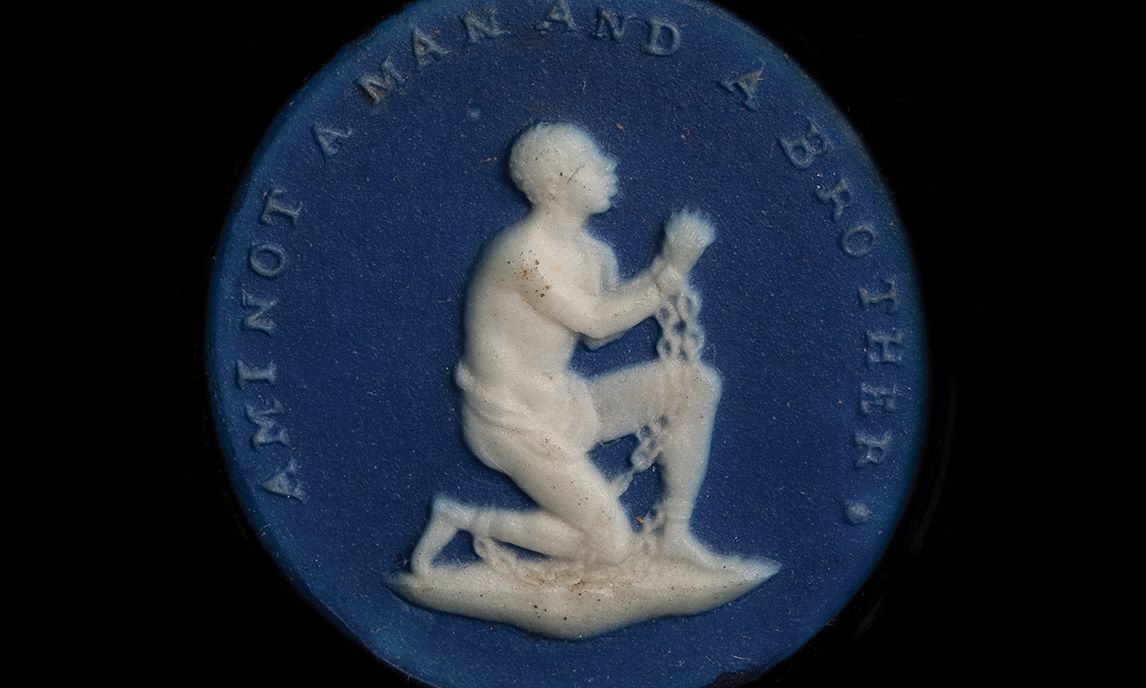An anti-slavery medallion (around 1787) from the American Philosophical Society, Philadelphia, attributed to Wedgwood and part of the campaign against the transatlantic slave trade
American Philosophical Society, Philadelphia
This book, written by Iris Moon, a curator at the Metropolitan Museum of Art, New York, who took her doctorate at Massachusetts Institute of Technology, is not aimed at the Wedgwood collector. Of small format and printed on blue paper, it has only 12 colour plates. Many illustrations were taken by the author herself, with greater or lesser success. Surprisingly, quite a number are of a highly personal nature, the portrait of the author’s grandmother perhaps the most notable of these. Regrettably, neither the format of the book nor the paper chosen for the illustrations, taken from a variety of sources, are suited to the reproduction of black-and-white images. Quite a number, including important archival documents, are indecipherable. Many of these are hitherto unpublished, which is additionally frustrating. These shortcomings are the fault of the MIT Press, rather than the author.
Unlike the majority of writers on Josiah Wedgwood I (1730-95) and his career, of which there have been many, most recently Tristram Hunt (The Radical Potter: Josiah Wedgwood and the Transformation of Britain, Allen Lane 2021), Moon chooses neither to take the traditional chronological and biographical approach, nor to illustrate a series of Wedgwood wares. Instead she ranges widely over her subject in four chapters: “Phantom Urn”, on Wedgwood’s productions and their reliance on classical models, his disability, and his planning of the new factory at Etruria in Stoke-on-Trent, where he instituted a new system of controlling his workforce; “A Body for Stubbs”, an analysis of the painter George Stubbs’s career and his work for Wedgwood; “Black and Blue”, concerning the background to Wedgwood’s slave medallion; and “His Son’s Shadow”, about Josiah’s son Thomas (1771-1805). Highly discursive, these essays present a different view of the potter, his life and his family, and offer some stimulating insights.
George Stubbs collaborated with Wedgwood to create the enamel-on-earthenware plaque Reapers (1795)
Yale Center for British Art
The author’s perspective is deeply personal, and of its time. A Korean American, Moon states that Britain in the 18th century is a foreign country to her, but nevertheless she has immersed herself in the history and heritage of the Potteries, visited many, or indeed most, of the key sites in Stoke-on-Trent and the surrounding area, including shraff fields (pottery rubbish tips made up of many discarded pots), for which she gives no precise location. She has much to say about interesting examples of Wedgwood in her care at the Metropolitan Museum. Many have been awaiting publication for some years now, so it is gratifying that a young scholar is at last analysing and illustrating them. It is disappointing that illustrations of important vases, such as the so-called Pegasus Vase, named for its finial, are monochrome. Several paintings by Stubbs, whose work is discussed at length, are in black and white only. While well known to many art historians, it is a pity that the skill of the painter is less evident than the ideas the writer finds enshrined in these works.
In many ways idiosyncratic, this book could be considered a milestone in Wedgwood studies, as its focus is on Wedgwood the man, as well as on his son Thomas, often considered (though not by Moon) to have played a role in the development of photography. In some respects it represents the author’s own personal journey of discovery. She records her visits to the Yale Center for British Art, New Haven, the Quaker Meeting House, Philadelphia, the Wedgwood Archive and Museum at Barlaston, Staffordshire, the Potteries Museum, and the Trent and Mersey Canal. Moon often uses the personal pronoun, a habit that in academic circles has traditionally been discouraged. The author’s own photographs, of varying quality, are reminiscent of W.G. Sebald’s novels illustrated with pictures of his own family.
However, there is a wealth of detail about Josiah, including much about his disability. It is a little-known fact outside Wedgwood scholars and collectors that Josiah had a wooden leg, or a series of prostheses, following the amputation of his diseased right leg in 1768 shortly before the beginning of his ornamental partnership with Thomas Bentley. His surviving letters to Bentley leave the impression that after his recovery from the operation, Wedgwood, like many amputees, did not let his disability prevent him from carrying on his business, though he rarely travelled far from home. Moon makes much of the topic of disability in the 18th century, which has had little attention. She also devotes a long chapter to extensive discussion of the background to Wedgwood’s jasper anti-slavery medallion, which played its part in the fight against the transatlantic slave trade. The little-known blue jasper medallion, in the American Philosophical Society, Philadelphia (illustrated in colour), is of uncertain provenance and the inscription is rather poorly executed. It was perhaps made by one of Wedgwood’s competitors, although this reviewer has never examined it.
The author’s digressions, with their accompanying illustrations, are thought-provoking, although not always in direct relationship to her chosen subject, as in the case of her exploration of birth in her discussion of Stubbs’s early engravings to illustrate John Burton’s 1751 treatise on midwifery. Occasionally her lack of broad knowledge of the ceramic field results in inaccuracies: ornamental ceramic vases were made before the mid-18th century; tin-glazed earthenware (maiolica) and porcelain vases were made in Renaissance Italy; early-18th century porcelain vases were made at several European factories, such as at Saint-Cloud, near Paris; although “vase mania”, an international phenomenon, was a feature of Josiah’s own time.
• Melancholy Wedgwood, by Iris Moon. The MIT Press, 248pp, 85 b/w and 12 colour illustrations, $34.95/£32, published 23 January

